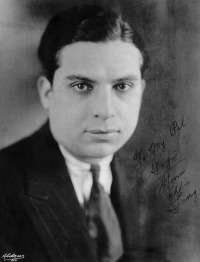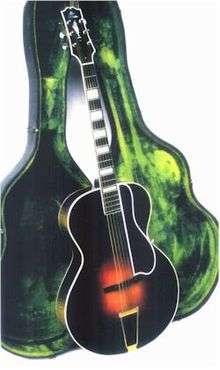Eddie Lang
| Eddie Lang | |
|---|---|
 | |
| Background information | |
| Birth name | Salvatore Massaro |
| Also known as | Blind Willie Dunn |
| Born |
October 25, 1902 Philadelphia, United States |
| Died |
March 26, 1933 (aged 30) New York, United States |
| Genres | Jazz , chamber jazz |
| Occupation(s) | Musician |
| Instruments | Guitar, violin, banjo |
| Associated acts | Joe Venuti, Paul Whiteman, Bing Crosby, Annette Hanshaw, Lonnie Johnson |
| Notable instruments | |
| Gibson L-4, Gibson L-5 | |
- For the blues singer Eddie Lang (singer)
Eddie Lang (October 25, 1902 – March 26, 1933) was an American jazz guitarist, regarded by some as the Father of Jazz Guitar.[1] He played a Gibson L-4 and L-5 guitar, providing great influence for many guitarists including Django Reinhardt.[2]

Biography
Lang was born Salvatore Massaro, the son of an Italian-American[3] instrument maker in Philadelphia. He first took violin lessons for 11 years. In school he became friends with Joe Venuti, with whom he would work for much of his career.[4] He was playing professionally by about 1918, playing violin, banjo and guitar. He worked with various bands in the USA's Northeast, worked in London (late 1924 to early 1925), then settled in New York City.
Lang was the first important jazz guitarist. He was effectively able to integrate the guitar into 1920s jazz recordings. He played with the bands of Joe Venuti, Adrian Rollini, Roger Wolfe Kahn and Jean Goldkette, in addition to doing a large amount of freelance radio and recording work. While most bands of the time had a banjo player (the banjo being louder than the guitars of the time), Lang was skilled enough to make his acoustic guitar be heard in the mix; he was so influential that, according to George Van Eps, banjo players had no choice but to switch to guitar.[5]
On February 4, 1927, Lang featured in the recording of "Singin' the Blues" by Frankie Trumbauer and His Orchestra featuring Bix Beiderbecke on cornet. Lang traded guitar licks while Beiderbecke soloed on cornet, in a landmark jazz recording of the 1920s.[4]
In 1929, he joined Paul Whiteman's Orchestra, and can be seen and heard in the movie King of Jazz. In 1930, Lang played guitar on the original recording of the jazz and pop standard "Georgia on My Mind", recorded with Hoagy Carmichael and His Orchestra. Joe Venuti and Bix Beiderbecke also played on this recording.
When Bing Crosby left Whiteman, Lang went with Crosby as his accompanist, and can be seen with him in the 1932 movie The Big Broadcast. Lang also played under the pseudonym Blind Willie Dunn on a number of blues records with Lonnie Johnson,[4] to mask his race.[5]
Lang died following a tonsillectomy[6] in New York City in 1933 at the age of thirty. He had been urged by Crosby to have the tonsillectomy so that he might have speaking parts in Crosby's films. Lang's voice was chronically hoarse, and it was hoped that the operation would remedy this. It is unclear exactly what the cause of death was, but it is thought that uncontrolled bleeding played a role. Author James Sallis claims that he died when he developed an embolism while still under anesthetic and never regained consciousness.[7]
Influence and legacy
Lang's compositions, based on the Red Hot Jazz database, included "Wild Cat" with Joe Venuti, "Perfect" with Frank Signorelli, "April Kisses" (1927), "Sunshine", "Melody Man's Dream", "Goin' Places", "Black and Blue Bottom", "Bull Frog Moan", "Rainbow Dreams", "Feelin' My Way", "Eddie's Twister", "Really Blue", "Penn Beach Blues", "Wild Dog", "Pretty Trix", "A Mug of Ale", "Apple Blossoms", "Beating the Dog", "To To Blues", "Running Ragged", "Kicking the Cat", "Cheese and Crackers", "Doin' Things", "Blue Guitars", "Guitar Blues" with Lonnie Johnson, "Hot Fingers", "Have to Change Keys to Play These Blues", "A Handful of Riffs", "Blue Room", "Deep Minor Rhythm Stomp", "Two-Tone Stomp". "Midnight Call Blues", "Four String Joe", "Goin' Home", and "Pickin' My Way" (1932) with Carl Kress.[8]
Jazz guitarist George Van Eps assessed the legacy of Eddie Lang: "It's very fair to call Eddie Lang the father of jazz guitar". Barney Kessel noted that "Eddie Lang first elevated the guitar and made it artistic in jazz." Les Paul acknowledged that "Eddie Lang was the first and had a very modern technique." Joe Pass, in a 1976 interview, stated that Lang was one of the three main guitar innovators, along with Wes Montgomery and Django Reinhardt.
In 1977, Lang's recording of "Singin' the Blues" with Frankie Trumbauer and His Orchestra featuring Bix Beiderbecke on cornet was inducted into the Grammy Hall of Fame.
In 1986, Lang was inducted into the Big Band and Jazz Hall of Fame.
In 2006, his 1927 recording of "Singin' the Blues" with Bix Beiderbecke and Frankie Trumbauer was placed on the U.S. Library of Congress National Recording Registry.
In 2010, he was one of the ASCAP Jazz Wall of Fame inductees.[9]
Major recordings
- "Stringin' the Blues" [Take 11], with Joe Venuti, November 8, 1926
- "Hurricane", Red Nichols and His Five Pennies, January 12, 1927
- "Wild Cat", with Joe Venuti, January 24, 1927, New York, Okeh 40762-A
- "Sunshine", with Joe Venuti, January 24, 1927, New York, Okeh 40762-B
- "Singin' the Blues", recorded on February 4, 1927, with Frankie Trumbauer and Bix Beiderbecke in New York and released as Okeh 40772
- "April Kisses" b/w "Eddie's Twister", recorded April 1. 1927, Okeh 40807
- "Doin' Things", with Joe Venuti, May 4, 1927
- "Goin' Places", with Joe Venuti, May 4, 1927
- "For No Reason at All in C" with Frankie Trumbauer and Bix Beiderbecke, recorded on May 13, 1927, in New York and released as Okeh 40871, Columbia 35667, and Parlophone R 3419
- "Beating the dog",with Joe Venuti and Adrian Rollini,recorded on June 28, 1927,New York,Okeh
- "Wringin' An' Twistin', with Frankie Trumbauer and Bix Beiderbecke, September 17, 1927, OKeh 40916
- "Perfect", October 21, 1927, New York, Okeh 40936
- "Four String Joe*, Joe Venuti's Blue Four, November 15, 1927
- "Guitar Blues", with Lonnie Johnson, May 7, 1929, in New York, released as Okeh 8711
- "Knockin' A Jug", with Louis Armstrong and Jack Teagarden, March 5. 1929
- "Kitchen Man", with Bessie Smith, May 8, 1929
- "A Bench in the Park", Paule Whiteman and His Orchestra, March 21, 1930
- "Georgia on My Mind", with Hoagy Carmichael on vocals, Bix Beiderbecke on cornet, recorded on September 15, 1930, in New York and released as Victor 23013
- "Pickin' My Way", with Carl Kress, recorded January 15, 1932, Brunswick 1282
- "Feelin' My Way", with Carl Kress, January 17, 1932, Brunswick 1282
- "Please", with Bing Crosby, recorded September 16, 1932, no. 1 for 6 weeks
- "Jig Saw Puzzle Blues", Joe Venuti and Eddie Lang's Blue Five, recorded February 28, 1933
Bibliography
- Peters, Mike. The Classic Columbia and Okeh Joe Venuti and Eddie Lang Sessions. Notes by Mike Peters, Marty Grosz, Richard M. Sudhalter, Scott Wenzel. Mosaic Records, 2002.
- Mazzoletti, Adriano. Eddie Lang: Stringin' The Blues. Rome, Italy: Pantheon Editore, 1997.
- Sallis, James, editor. Jazz Guitar: An Anthology. Quill Publishers, 1984.
- Worsfold, Sally-Ann. The Quintessential Eddie Lang, 1925–1932. Timeless Records, 1997.
- Berend, Dave. Seven Original Compositions For The Guitar by the Great Eddie Lang: Transcribed and Arranged for Plectrum Guitar Solos with Guitar Accompaniment. Robbins Music, 1961.
References
- ↑ Ferguson, Jim (1983). Father Of Jazz Guitar. GPI Publications. pp. 78–86.
- ↑ Berendt, Joachim E (1976). The Jazz Book. Paladin. p. 268.
- ↑ Lang's father was born in Monteroduni, an Italian village in Molise. The township of Monteroduni hosts every year a commemorative "Eddie Lang Jazz Festival". See
- 1 2 3 Lyttelton, Humphrey (1998). The Best of Jazz. Robson Books. pp. 139–140. ISBN 1-86105-187-5.
- 1 2 Obrecht, Jay (December 2015). "The Lonnie Johnson-Eddie Lang Duets". Guitar Player. pp. 26–30, 140.
- ↑ Jazz and Otolaryngology: The Death of Guitarist Eddie Lang
- ↑ The Guitar Players - One Instrument and Its Masters in American Music by James Sallis 1982
- ↑ Eddie Lang at RedHot Jazz
- ↑ 2010 ASCAP Jazz Wall of Fame Inductees.
External links
- Official website featuring biography, discography, recordings, images, films, and radio sessions
- Eddie Lang Jazz Festival
- Photograph of Eddie Lang with Bing Crosby
|